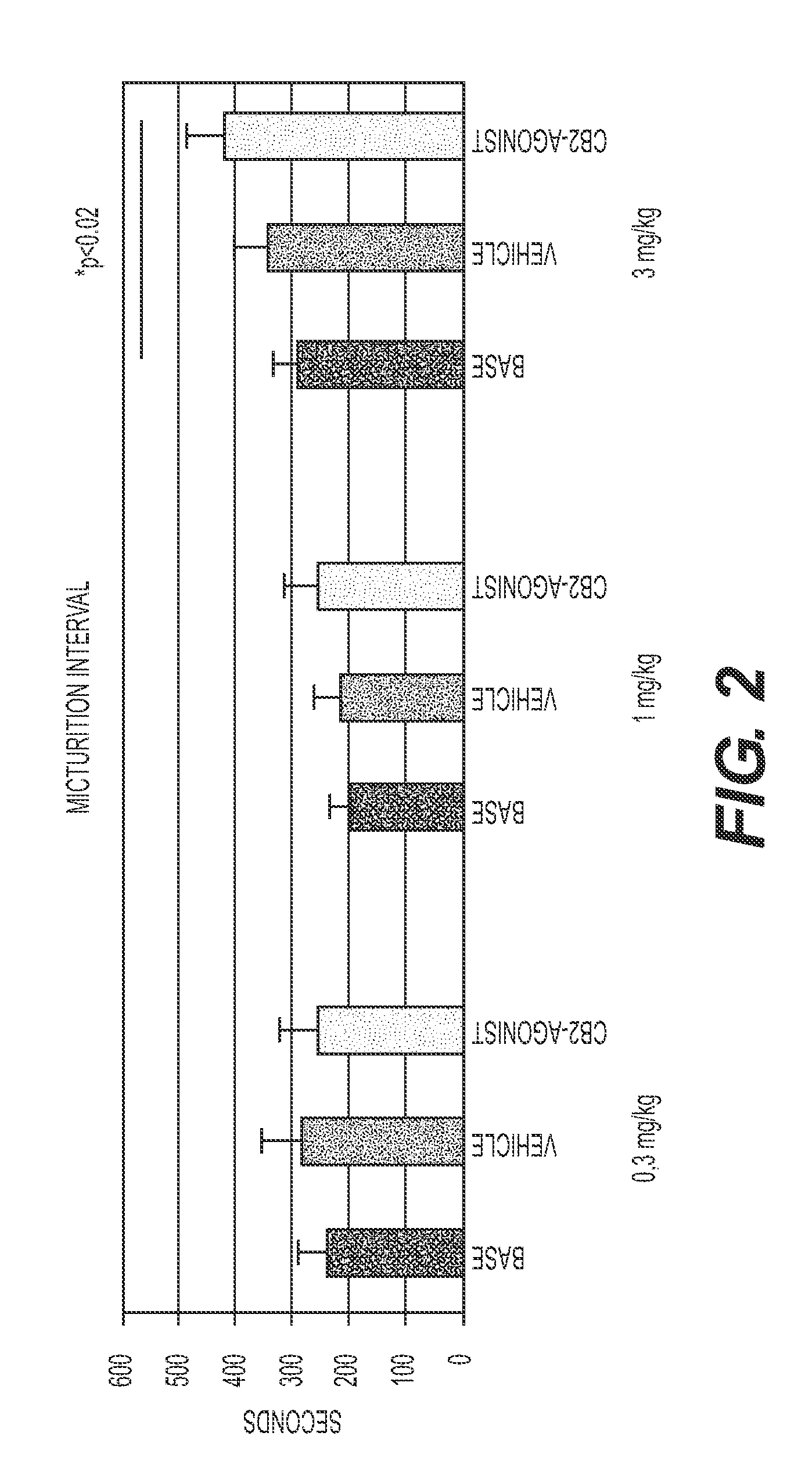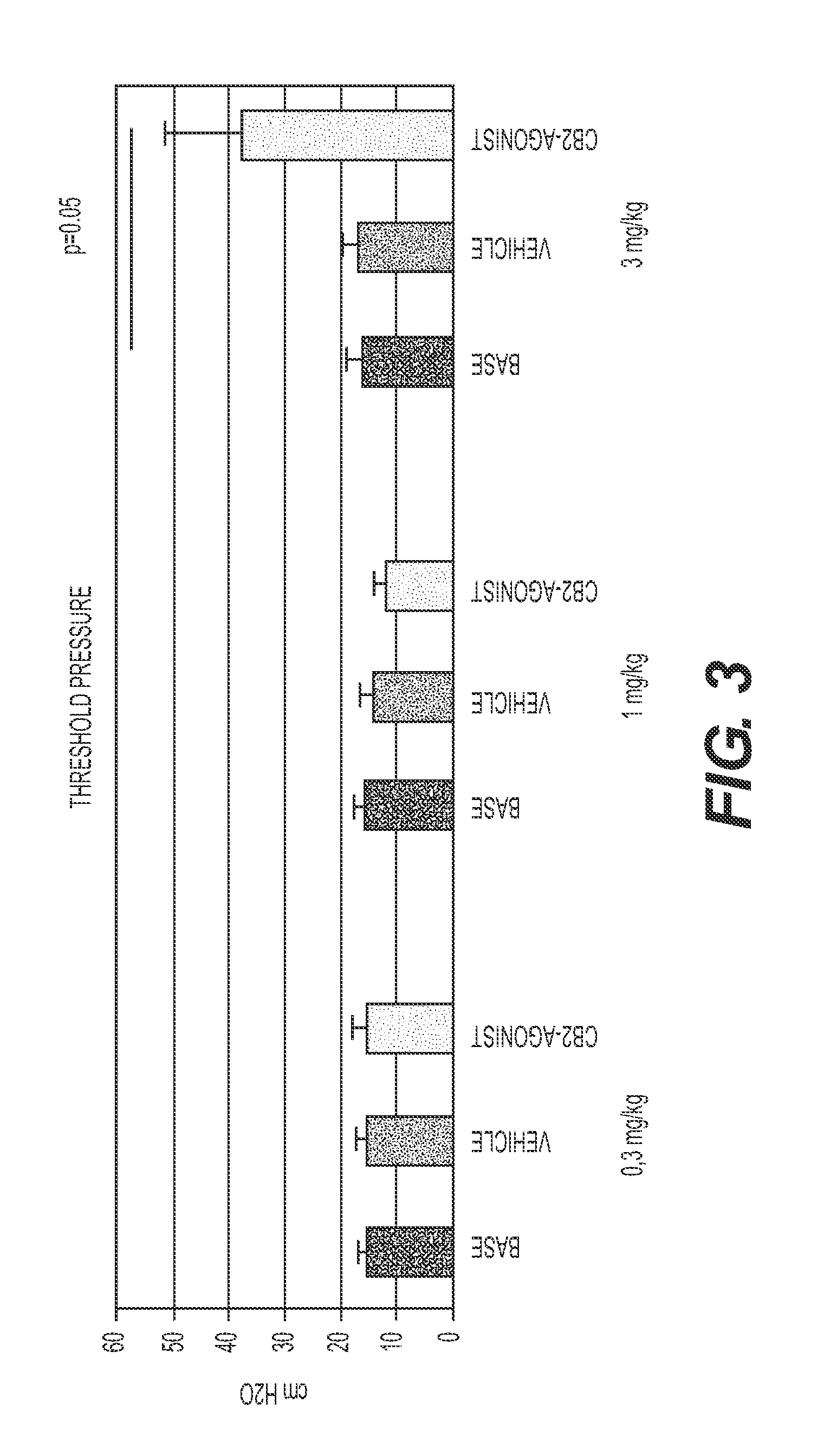Treatment Of Lower Urinary Tract Dysfunction With CB2-Receptor-Selective Agonists
a technology of cb2 receptor and agonist, which is applied in the direction of biocide, animal repellents, drug compositions, etc., can solve the problems of limited efficacy, adverse side effects, and 80% of patients no longer continuing treatment, and achieve the effect of treating or preventing lower urinary tract dysfunction
- Summary
- Abstract
- Description
- Claims
- Application Information
AI Technical Summary
Problems solved by technology
Method used
Image
Examples
example 1
Physicochemical Properties
[0078]Information regarding certain physicochemical properties of the compounds of Formulas I, II, III and IV are presented in the following Table. Expected water solubility, logP and logD at pH 7 were calculated using Advanced Chemistry Development software (ACD labs, version 4.04). THC and Nabilone, being both commercially available cannabinoids, are reported herein as references.
TABLE 1Selected physicochemical propertiesCompoundStructureMWSolubilityLogPLogD, pH7Δ9-THC314.46400ng / ml7.68 ± 0.357.68Nabilone372.548ng / ml7.01 ± 0.397.01(I)(described herein)470.60>10mg / ml2.5(II)(described herein)358.516.5(III)(described herein)330.267.9(IV)(described herein)439.286.8
The actual solubility of certain compounds of the invention was assessed in aqueous buffers and final concentration of compounds was determined using HPLC and spectrophotometer methodologies.
example 2
Binding Affinity for the CB1 and CB2 Receptors
[0079]The CB1 and CB2 binding assays were performed as described in International Patent Applications WO 06 / 129318 and results, expressed as IC50 in nM, are reported in the following table. Binding affinity is represented by an IC50 value, which is the concentration of a test compound that will displace 50% of a radiolabeled agonist from the CB receptors.
TABLE 2IC50 (nM) of compounds of formula (I), (II) and (III)Evaluation of therapeutic effects of the compounds ofFormulas I, II, III and IV was carried out in experiments to showthe use of these compounds as agents for the treatment ofLUTD. These effects were evaluated as set forth below.CB2 / CB1affinityCompoundCB2 IC50CB1 IC50ratioTHC*36.440.70.89(I)19.466034(II)8.418121(III)6.59214(IV)3031310
example 3
Effect of Compounds on Cystometry in an Acetic Acid Model
[0080]This study involved an assessment of the acute effect of the compounds of Formulas II, III and IV, which exhibit varying degrees of CB2 / CB1 affinity (Table 2), on bladders in urethane-anesthetized rats in an acetic acid model using cystometry. As used herein, the term “acute” means that the animals were dosed only one time, 30 minutes prior to taking the cystometry measurements (i.e., 30 minutes prior to the observation period). The acetic acid-induced model is an irritative model in which increased micturition frequency (decreased micturition interval) and reduced bladder capacity cystometry may be obtained after an intravesical infusion of a dilute solution of acetic acid (McMurray G, Casey J H, Naylor A M. Animal models in urological disease and sexual dysfunction. Br J Pharmacol. 2006; 147 Suppl:S62; Kakizaki H, de Groat W C. Role of spinal nitric oxide in the facilitation of the micturition reflex by bladder irritat...
PUM
| Property | Measurement | Unit |
|---|---|---|
| pH | aaaaa | aaaaa |
| flow rate | aaaaa | aaaaa |
| basal bladder pressure | aaaaa | aaaaa |
Abstract
Description
Claims
Application Information
 Login to View More
Login to View More - R&D
- Intellectual Property
- Life Sciences
- Materials
- Tech Scout
- Unparalleled Data Quality
- Higher Quality Content
- 60% Fewer Hallucinations
Browse by: Latest US Patents, China's latest patents, Technical Efficacy Thesaurus, Application Domain, Technology Topic, Popular Technical Reports.
© 2025 PatSnap. All rights reserved.Legal|Privacy policy|Modern Slavery Act Transparency Statement|Sitemap|About US| Contact US: help@patsnap.com



